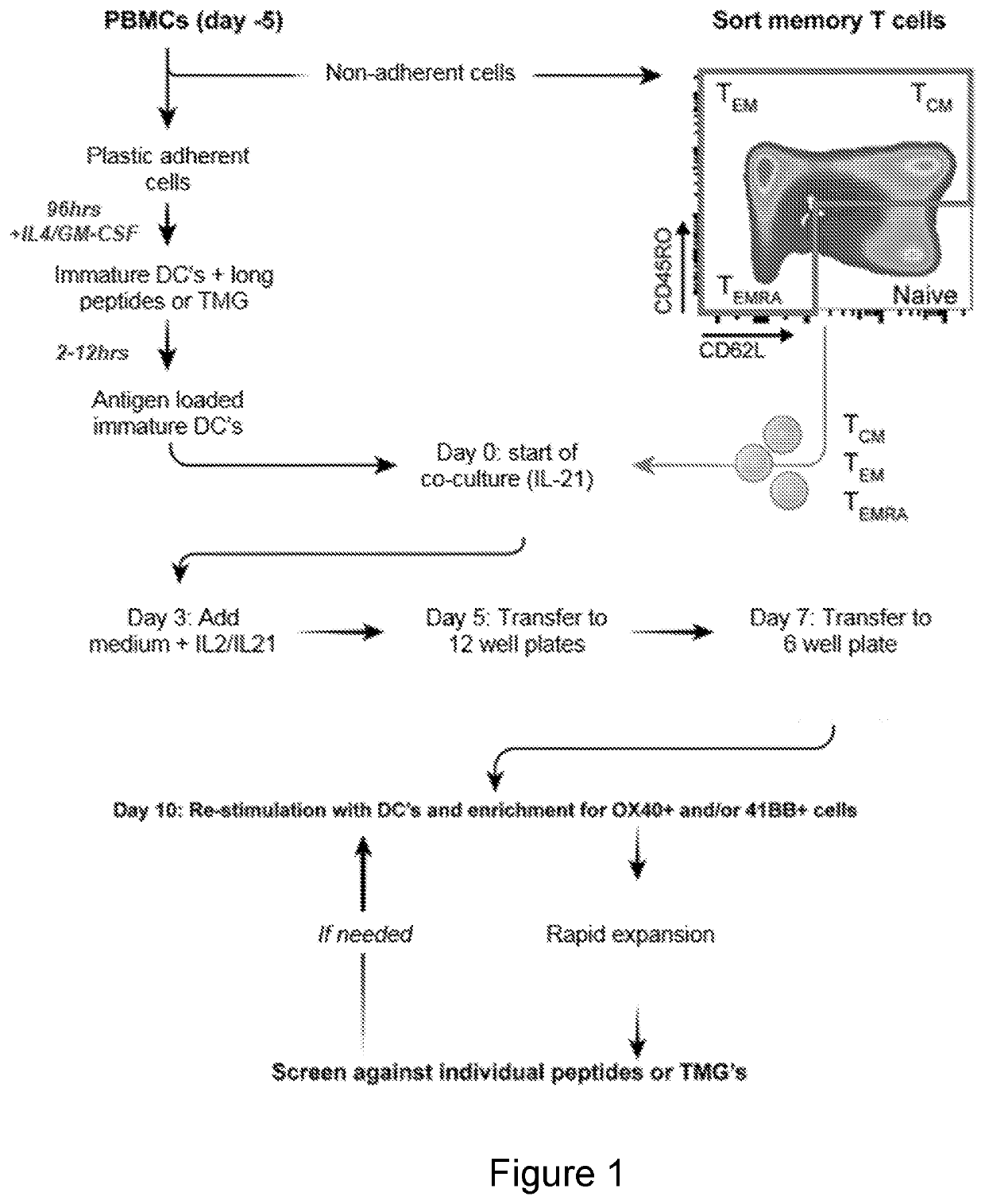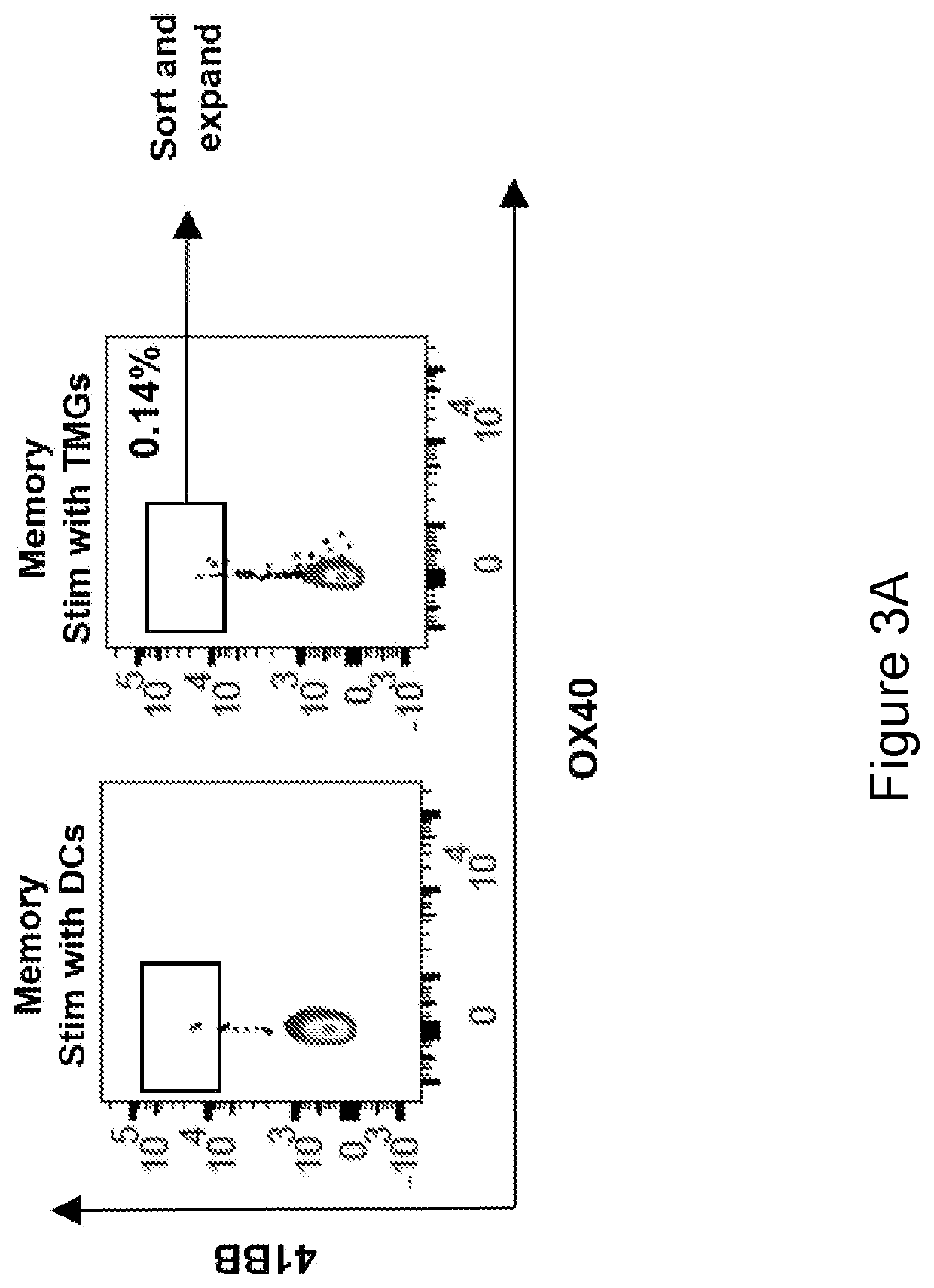Methods of enriching cell populations for cancer-specific t cells using in vitro stimulation of memory t cells
a technology of in vitro stimulation and memory t cells, which is applied in the field of enriching cell populations for cancer-specific t cells using in vitro stimulation of memory t cells, can solve the problems of difficult identification and/or isolation of t cells and tcrs that specifically recognize cancer antigens from patients, and obstacles to the successful use of act for the widespread treatment of cancer and other diseases
- Summary
- Abstract
- Description
- Claims
- Application Information
AI Technical Summary
Benefits of technology
Problems solved by technology
Method used
Image
Examples
example 1
[0112]This example demonstrates a method of obtaining a cell population enriched for T cells having antigenic specificity for a cancer-specific mutation.
[0113]The following materials and methods were employed in the experiments described in Example 1.
[0114]Reagents:[0115](a) Peripheral blood leukocytes.[0116](b) Dendritic cell medium: (RPMI 1640 Media supplemented with 2 mM L-glutamine, 10 mM Hepes buffer, 1× non-essential amino acids, 25 μg / ml gentamicin, and 1% human AB sera).[0117](c) CTL cell medium: (50 / 50 RPMI and AIM-V mediums supplemented with 10 mM Hepes buffer, 25 ug / ml gentamicin, and 10% human AB sera).[0118](d) Dulbecco's phosphate buffered saline (PBS).[0119](e) Recombinant human IL-4 (Peprotech, Rocky Hill, N.J.).[0120](f) Recombinant human GM-CSF (Peprotech).[0121](g) Recombinant Human IFN-γ (Peprotech, cat. no. 300-02).[0122](h) Recombinant Human IL-7 (Peprotech).[0123](i) Recombinant Human IL-15 (Peprotech).[0124](j) Recombinant Human IL-21 (Peprotech).
[0125]Antibo...
examples 2-6
[0221]The following materials and methods were employed in the experiments described in Examples 2-6.
In-Vitro Stimulation of Naïve and Memory T Cells
[0222]A. Generation of Monocyte-Derived Immature DCs
[0223]Apheresis samples were thawed, washed, set to 5-10×106 cells / ml with AIM-V media (Life Technologies), and 1.75-2×108 viable cells were incubated in T175 flasks (Corning Inc.) at 37° C. After 2 hours, the flasks were washed 2-3 times vigorously with PBS to collect non-adherent cells for T cell sorting. For the adherent cells, 30 ml DC media were added, comprised of RPMI containing 5% human serum, 100 U / ml penicillin and 100 μg / ml streptomycin, 2 mM L-glutamine, 800 IU / ml GM-CSF (Leukine) and 200 U / ml IL-4 (Peprotech), and cells were incubated at 37° C., 5% CO2. On day 4 or 5, cells were harvested and freshly used or frozen for further use. DCs were seeded into low attachment 12- or 6-well plates for peptide loading or TMG transfection. For peptide loading: DCs were loaded with 10-...
example 2
[0248]This example demonstrates that neoantigen-reactive TCRs were detected only in memory cells (TCM, TEM, and TEMRA) but not in TN cells.
[0249]To determine whether the neoantigen-reactive T cells are present in the memory compartment of epithelial cancer patients, the phenotype of PD-1+ T cells in the peripheral blood of four metastatic gastrointestinal (GI) cancer patients (patients 4217, 4254, 4257 and 4252) was initially tested. Analysis of all four samples revealed that the majority of CD3+PD1+ T cells were central memory T cells (TCM) or effector memory T cells (TEM) (FIGS. 4A-4B and 4E), while no TN cells were shown to be PD-1 positive. The majority of the terminally differentiated effector memory (TEMRA) cells did not express PD-1.
[0250]To further address whether neoantigen-specific T cells were enriched in the memory T cell subset, TN, TCM, TEM, and TEMRA cells from peripheral blood lymphocytes (PBL) of six epithelial cancer patients with known neoantigen-reactive TCRs tha...
PUM
| Property | Measurement | Unit |
|---|---|---|
| concentration | aaaaa | aaaaa |
| concentration | aaaaa | aaaaa |
| concentration | aaaaa | aaaaa |
Abstract
Description
Claims
Application Information
 Login to View More
Login to View More - R&D
- Intellectual Property
- Life Sciences
- Materials
- Tech Scout
- Unparalleled Data Quality
- Higher Quality Content
- 60% Fewer Hallucinations
Browse by: Latest US Patents, China's latest patents, Technical Efficacy Thesaurus, Application Domain, Technology Topic, Popular Technical Reports.
© 2025 PatSnap. All rights reserved.Legal|Privacy policy|Modern Slavery Act Transparency Statement|Sitemap|About US| Contact US: help@patsnap.com



